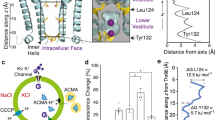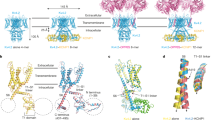Abstract
Direct interactions of phosphatidylinositol-4,5-bisphosphate (PtdIns(4,5)P2) with inwardly rectifying potassium channels are stronger with channels rendered constitutively active by binding to PtdIns(4,5)P2, such as IRK1, than with G-protein-gated channels (GIRKs). As a result, PtdIns(4,5)P2 alone can activate IRK1 but not GIRKs, which require extra gating molecules such as the βγ subunits of G proteins or sodium ions. Here we identify two conserved residues near the inner-membrane interface of these channels that are critical in interactions with PtdIns(4,5)P2. Between these two arginines, a conservative change of isoleucine residue 229 in GIRK4 to the corresponding leucine found in IRK1 strengthens GIRK4–PtdIns(4,5)P2 interactions, eliminating the need for extra gating molecules. A negatively charged GIRK4 residue, two positions away from the most strongly interacting arginine, mediates stimulation of channel activity by sodium by strengthening channel–PtdIns(4,5)P2 interactions. Our results provide a mechanistic framework for understanding how distinct gating mechanisms of inwardly rectifying potassium channels allow these channels to subserve their physiological roles.
This is a preview of subscription content, access via your institution
Access options
Subscribe to this journal
Receive 12 print issues and online access
$209.00 per year
only $17.42 per issue
Buy this article
- Purchase on Springer Link
- Instant access to full article PDF
Prices may be subject to local taxes which are calculated during checkout





Similar content being viewed by others
References
Hilgemann, D. W. & Ball, R. Regulation of cardiac Na+,Ca2+ exchange and KATP potassium channels by PIP2 . Science 273, 956–959 (1996).
Fan, Z. & Makielski, J. C. Anionic phospholipids activate ATP-sensitive potassium channels. J. Biol. Chem. 272, 5388–5395 (1997).
Huang, C. L., Feng, S. & Hilgemann, D. W. Direct activation of inward rectifier potassium channels by PIP2 and its stabilization by Gβγ. Nature 391, 803–806 (1998).
Sui, J. L., Petit Jacques, J. & Logothetis, D. E. Activation of the atrial KACh channel by the βγ subunits of G proteins or intracellular Na+ ions depends on the presence of phosphatidylinositol phosphates. Proc. Natl Acad. Sci USA 95, 1307–1312 (1998).
Shyng, S. L. & Nichols, C. G. Membrane phospholipid control of nucleotide sensitivity of KATP channels. Science 282, 1138–1141 (1998).
Baukrowitz, T. et al. PIP2 and PIP as determinants for ATP inhibition of KATP channels. Science 282, 1141–1144 (1998).
Hille, B. in Ionic Channels of Excitable Membranes Vol. 2 115–139 (Sinauer, Sunderland, 1992).
Logothetis, D. E., Kurachi, Y., Galper, J., Neer, E. J. & Clapham, D. E. The βγ subunits of GTP-binding proteins activate the muscarinic K+ channel in heart. Nature 325, 321–326 (1987).
Vivaudou, M. et al. Probing the G-protein regulation of GIRK1 and GIRK4, the two subunits of the KACh channel, using functional homomeric mutants. J. Biol. Chem. 272, 31553–31560 (1997).
He, C., Zhang, H., Mirshahi, T. & Logothetis, D. E. Identification of a potassium channel site that interacts with G protein βγ subunits to mediate agonist-induced signaling. J. Biol. Chem. 274, 12517–12524 (1999).
Ravichandran, K. S. et al. Evidence for a requirement for both phospholipid and phosphotyrosine binding via the Shc phosphotyrosine-binding domain in vivo. Mol. Cell Biol. 17, 5540–5549 (1997).
Liou, H.-H., Zhou, S.-S. & Huang, C.-L. Regulation of ROMK1 channel by protein kinase A via a phosphatidylinositol 4,5-bisphosphate-dependent mechanism. Proc. Natl Acad. Sci. USA 96, 5820–5825 (1999).
Sui, J. L., Chan, K. W. & Logothetis, D. E. Na+ activation of the muscarinic K+ channel by a G-protein- independent mechanism. J. Gen. Physiol. 108, 381–391 (1996).
Ho, I. H. M. & Murrell-Lagnado, R. Molecular determinants for sodium-dependent activation of G protein-gated K+ channels. J. Biol. Chem. 274, 8639–8648 (1999).
Chan, K.W. et al. A recombinant inwardly rectifying potassium channel coupled to GTP-binding proteins. J. Gen. Physiol. 107, 381–397 (1996).
Liman, E. R., Tytgat, J. & Hess, P. Subunit stoichiometry of a mammalian K+ channel determined by construction of multimeric cDNAs. Neuron 9, 861–871 (1992).
Chan, K. W., Sui, J. L., Vivaudou, M. & Logothetis, D. E. Control of channel activity through a unique amino acid residue of a G protein-gated inwardly rectifying K+ channel subunit. Proc. Natl Acad. Sci. USA 93, 14193–14198 (1996).
Horton, R. M., Hunt, H. D., Ho, S. N., Pullen, J. K. & Pease, L. R. Engineering hybrid genes without the use of restriction enzymes: gene splicing by overlap extension. Gene 77, 61–68 (1989).
Huang, C. L., Slesinger, P. A., Casey, P. J., Jan, Y. N. & Jan, L. Y. Evidence that direct binding of Gβγ to the GIRK1 G protein-gated inwardly rectifying K+ channel is important for channel activation. Neuron 15, 1133–1143 (1995).
Hamill, O. P., Marty, A., Neher, E., Sakmann, B. & Sigworth, F. J. Improved patch-clamp techniques for high-resolution current recording from cells and cell-free membrane patches. Pflugers Arch. 391, 85–100 (1981).
Hilgemann, D. W. in Single-Channel Recording (eds Sakmann, B. & Neher, E.) 307–327 (Plenum, New York, 1995).
Schreibmayer, W., Lester, H. A. & Dascal, N. Voltage clamping of Xenopus laevis oocytes utilizing agarose-cushion electrodes. Pflugers Arch. 426, 453–458 (1994).
Acknowledgements
We thank J.C. Garrison for purified Gβ1γ7 subunits; L. Lontsman for oocyte preparation; and R.F. Margolskee, S. Kupfer and M.M. Zhou for critical comments on the manuscript. This work was supported by a grant from the NIH (HL59949). H.Z. was supported by the Howard Hughes Medical Institute. T.M. was supported by an NIH training grant (HL07824).
Correspondence and requests for materials should be addressed to D.E.L.
Author information
Authors and Affiliations
Rights and permissions
About this article
Cite this article
Zhang, H., He, C., Yan, X. et al. Activation of inwardly rectifying K+ channels by distinct PtdIns(4,5)P2 interactions. Nat Cell Biol 1, 183–188 (1999). https://doi.org/10.1038/11103
Received:
Revised:
Accepted:
Published:
Issue Date:
DOI: https://doi.org/10.1038/11103
This article is cited by
-
Preliminary Study of the Anther-Specific Gene ZmMYB150 in Maize
Journal of Plant Growth Regulation (2022)
-
Selective binding of a toxin and phosphatidylinositides to a mammalian potassium channel
Nature Communications (2019)
-
Anionic Phospholipids Bind to and Modulate the Activity of Human TRESK Background K+ Channel
Molecular Neurobiology (2019)
-
Dual activation of neuronal G protein-gated inwardly rectifying potassium (GIRK) channels by cholesterol and alcohol
Scientific Reports (2017)
-
Hydrocinnamic Acid Inhibits the Currents of WT and SQT3 Syndrome-Related Mutants of Kir2.1 Channel
The Journal of Membrane Biology (2017)



